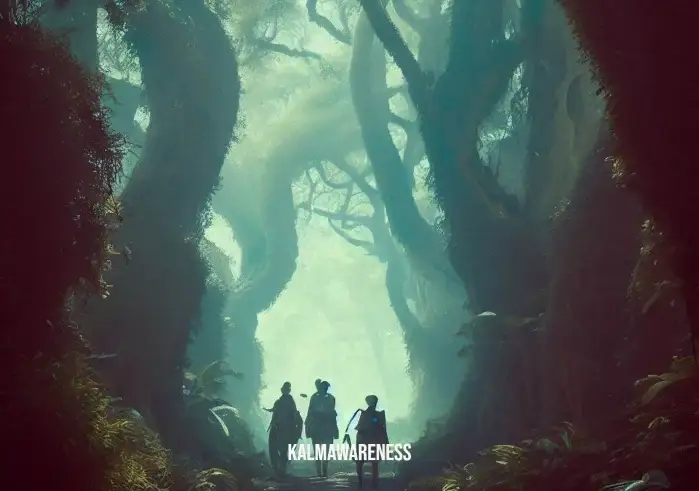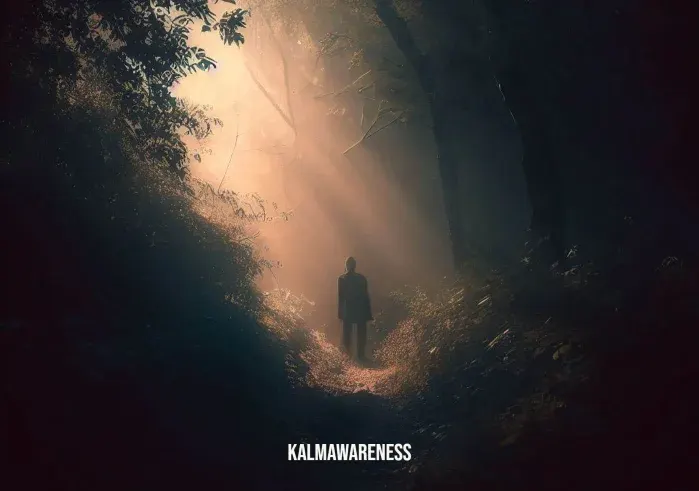Walking Through the Woods: A Journey of Mindfulness and Exploration
Walking through the woods is more than just a physical journey. It’s an exercise in mindfulness, an exploration of nature, and a chance to grow personally. It’s an experience that encourages you to aimlessly wander, embracing your curiosity and allowing the animation of the wilderness to guide you.
In this adventure, it’s more than okay to wander. In fact, at Kalm Awareness, we believe that when you embrace the chance to wander, you open yourself to the boundless possibilities nature presents, thereby fueling your personal growth.
The Allure of Aimless Wandering
As humans, we often find ourselves bound by the rigidity of schedules and the chains of expectation. However, the act of aimless wandering, especially when walking through the woods, allows us to break free from these constraints. Each footstep is a meditation of sorts, a rhythm that syncs with our heartbeat and the pulsating life that teems around us.
We propose an invitation for you to let go of your daily routines for a while and wander within the silent majesty of the forest. Here, each individual can choose to just be themselves or perhaps not be ‘themselves’ for a few precious moments.
“In every walk with nature, one receives far more than he seeks.” – John Muir
Nurturing Curiosity and Personal Growth
One of the gifts of walking through the woods is the opportunity it offers to nurture curiosity. As we walk and explore, we are faced with a myriad of stimuli that demand our attention. Our minds, uncluttered by the chaos of daily life, can truly appreciate the pictures of mindfulness that nature so generously offers.
Each rustle in the undergrowth, each bird’s melody, or the hum of a distant river might be an invitation to further exploration, to go beyond the realm of conscience. The simple act of walking becomes an animated journey of discovery, self-awareness, and growth.
The Therapeutic Potential of Forest Exploration
There is a poem by Mary Oliver that beautifully encapsulates the meditative and therapeutic potential of walking through the woods. She writes, “I don’t know exactly what a prayer is. I do know how to pay attention… how to be idle and blessed, how to stroll through the fields, which is what I have been doing all day.”
Indeed, the woods are a sanctuary, a temple of tranquillity where the mind can unwind, declutter, and heal. The Japanese have a term for this – ‘Shinrin-yoku’, or ‘forest bathing’, the practice of immersing oneself in the forest atmosphere.
We invite you to join us in the next part of this article where we delve deeper into the meditative practices you can incorporate while walking through the woods, the benefits of forest bathing, and how to nurture a deeper appreciation for nature. Embrace the journey, and remember, in the woods, every path leads to a newexperience and every trail winds towards self-discovery.
Harnessing the Power of Meditation
When we walk through the woods, we are in the perfect setting to engage in mindful meditation. As we traverse the verdant landscape, the serenity allows us to immerse ourselves fully in our surroundings, thereby grounding us in the present moment.
Try this: as you walk, close your eyes and take a moment to listen to the sounds of nature. The rustling leaves, chirping birds, the soft crunch underfoot… It’s almost as if you’re part of a curated nature meditation, an interactive mindfulness experience.
The practice of meditation, especially in the tranquility of the woods, can help you venture beyond the realm of conscience into a realm of elevated consciousness and spirituality. Here, you are free to confront your inner self, peeling away layers of the conscious mind to reveal a deeper understanding of your personal identity.
The Art of Forest Bathing
The Japanese practice of ‘Shinrin-yoku’, or ‘forest bathing’, goes beyond simply walking in the woods. It’s about immersing oneself in the environment and soaking in the forest atmosphere. It’s a form of therapy, a way to bridge the gap between ourselves and the natural world. In fact, the practice has been linked to a plethora of health benefits, including reduced stress, improved mood, and boosted immunity.
Take a moment to observe the calming trees, their leaves whispering secrets to the wind. Feel the sturdy earth beneath your feet, anchoring you in the present moment. Even when we’re walking through the woods in a group, we can find solace in moments of solitude. These images of solitude captured in the heart of nature help us explore and understand our feelings in a fresh and compassionate manner.
Nurturing an Appreciation for Nature
When we are walking through the woods, we are guests in a world that exists independently of human interference. We become observers, participants in an ecosystem that thrives in its cycles of life. In these moments of exploration and observation, we nurture an appreciation for nature.
Whether we’re admiring the ethereal beauty of an autumn cabin nestled among the trees, or reveling in the refreshing sensation of breathing in the crisp forest air, the experience helps us connect with our primal roots.
We invite you to journey further with us in the next chapter, where we will explore more aspects of this profound connection with nature. We’ll delve into the sensory experiences, explore mindfulness techniques, and guide you towards the ultimate peace and tranquility that can be achieved by simply walking through the woods.

The Sensory Experience of Walking Through the Woods
Walking through the woods is not just about the destination, but rather about the sensory experiences we engage in along the way. This journey of exploration is laden with a variety of sensory stimuli, which serve to deepen our connection with nature.
Sight
Among the first senses to be delighted in a woodland walk is our sense of sight. The woods offer a vibrant spectrum of colors and textures to marvel at. From the ever-changing hues of leaves to the dappled sunlight filtering through the trees onto a green pathway, the visuals are captivating.
In particular, the way sunlight interplays with the foliage, creating a dance of shadows and light, is an experience that never ceases to intrigue. This visual feast not only soothes our eyes but also calms our mind, offering a form of visual meditation.
Sound
The woods are far from silent. They are full of natural sounds that can be both soothing and invigorating. The melodious bird songs, the rustle of leaves underfoot, the relaxing patter of rain on foliage, or even the hushed whispers of the wind through the branches create an orchestra of natural sounds.
By listening mindfully to these sounds, we can train our ears to discern the unique calls of different birds or the subtle shifts in wind patterns. This deepens our connection with nature and enhances our overall experience of walking through the woods.
Smell
The scent of the woods is a potent mix of earthy and fresh notes. The aroma of damp earth, the delicate scent of wildflowers, the crisp fragrance of pine needles – all combine to create a unique perfume that is both calming and invigorating.
This experience is akin to nature’s version of aromatherapy. In fact, some scents, like pine, have been found to have a calming effect on our nervous system.
Mindfulness Techniques for Forest Exploration
Practicing mindfulness as we walk through the woods can further enhance this multi-sensory experience. Here are a few techniques to help you on this journey:
- Mindful Walking: This involves bringing your attention to the process of walking itself. Feel each footstep, listen to the crunch of leaves underfoot, and notice the subtle shifts in your body with each step. The guided meditation walk in the woods is a fantastic resource for learning this technique.
- Breath Awareness: As you walk, bring your attention to your breath. Notice the cool air entering your nostrils and the warm air leaving. You can combine this with mindful walking for a more immersive mindfulness practice.
- Nature Meditation: Find a quiet spot, maybe under a mindfulness tree, and sit quietly. Focus your attention on the sounds, smells, and sensations around you. This nature meditations deck can be a helpful guide.
| Technique | What to do | Link |
|---|---|---|
| Mindful Walking | Focus on each step, feel the ground under your feet | Link |
| Breath Awareness | Focus on your breath, notice the in and out rhythm | Link |
| Nature Meditation | Sitquietly, immerse in the sounds and sensations around you | Link |
As we continue our exploration, we invite you to delve deeper into the next chapter where we will consider the emotional and psychological benefits of walking through the woods. We’ll explore how the experience can promote mental health, inspire creativity, and foster a deeper sense of personal identity. So, let’s keep wandering on this enlightening journey through the woods.

The Emotional and Psychological Joys of Walking Through the Woods
The act of walking through the woods is not only a feast for the senses but also a balm for the mind and heart. The serenity and beauty of nature have a profound way of comforting our spirits, healing our minds, and nurturing our emotional well-being.
The Healing Power of Nature
American author John Burroughs once wrote, “I go to nature to be soothed and healed, and to have my senses put in order.” This resonates deeply with the experience of immersing oneself in the woods. Nature offers us a quiet respite, a place where we can disconnect from our daily stressors and reconnect with our inner peace.
Walking through the woods is akin to embarking on a journey inward, a journey of self-discovery and self-reflection. It’s about exploring not just the external landscapes but also the inner realms of consciousness. The tranquility of the woods provides the perfect backdrop for introspective practices like meditation and mindfulness.
Meditating in the heart of nature can be a powerful experience. The woods offer an escape from the noise and distractions of daily life, allowing you to focus inward, to reflect, and to reconnect with your inner self. This can be particularly beneficial for those dealing with mental health issues like stress, anxiety, and depression.
Inspiration and Creativity
Aside from its healing effects, the woods can also be a powerful source of inspiration. There’s a reason why so many artists, writers, and thinkers have sought solace in the woods. The unique mix of tranquility, beauty, and grandeur that nature offers can stimulate our creativity in ways that few other environments can.
“Come to the woods, for here is rest. There is no repose like that of the green deep woods,” wrote John Muir, the renowned naturalist and author. When we’re walking through the woods, away from the distractions of modern life, we allow our minds to wander, to dream, and to conjure new ideas.
Our curiosity is animated, the world around us seems richer, and we start to see things from a fresh perspective. It’s as if the woods open up a gateway to our most creative selves, allowing us to tap into that wellspring of inspiration within us.
Identity and Self-Discovery
Lastly, walking through the woods can be a journey of self-discovery. As we wander amidst the trees, we’re presented with an opportunity to face ourselves, to contemplate our existence, and to question our place in the world.
This experience, while humbling, can also be incredibly empowering. It allows us to confront our inner fears, to reevaluate our beliefs, and to better understand our true nature.
In the words of philosopher Friedrich Nietzsche, “All truly great thoughts are conceived while walking.” As we tread along the forest paths, we gain a clearer insight into who we are and what truly matters to us, thereby facilitating personal growth and self-understanding.
Join us in the next chapter as we delve further into the ways walking through the woods can shape our connection with the world, and explore the spiritual dimensions of this transformative practice. We will also touch upon techniques for enhancing mindfulness during woodland walks, using nature’s own tools. So stay with us on this enriching journey through the woods.

Unleashing the Power of Presence: Walking through the Woods as a Mindfulness Practice
Walking through the woods can be more than a pleasant pastime or a gentle form of exercise. With the right mindset and approach, it can become a potent practice of mindfulness and presence, offering a direct pathway to inner peace and wisdom.
Embracing the Here and Now
One of the most powerful aspects of walking through the woods is the opportunity it provides for mindfulness practice. To be mindful is to be fully present, fully engaged with whatever we are doing at the moment.
As Thich Nhat Hanh, the Vietnamese Zen master, puts it, “Walk as if you are kissing the Earth with your feet.” This profound quote captures the essence of mindful walking. Each step taken in awareness is an act of love, a gesture of deep respect and appreciation for the natural world around us.
A walk in the woods is a sensory feast, a delightful symphony of sights, sounds, and smells. By consciously tuning into these sensory experiences, we ground ourselves in the present moment, letting go of our preoccupations with the past and the future.
Being mindful while walking in the woods enhances our connection with the natural world, enriches our sensory perceptions, and allows us to experience the full beauty and richness of the present moment.
Techniques for Mindful Walking
When walking through the woods, there are several techniques you can employ to deepen your mindfulness practice.
- Breathing: Breathing is a cornerstone of mindfulness. Focus on your breath as you walk, synchronizing your steps with your breath. Inhale deeply as you lift your foot and exhale as you set it down. This technique, called nature breathing, can help to calm your mind and anchor you in the present moment.
- Sound meditation: Tune into the sounds around you. The rustle of leaves, the chirping of birds, the gentle breeze. Don’t judge or analyze these sounds. Just listen and observe. This is a form of sound meditation.
- Visual meditation: Gaze at the colors and shapes of the trees, the dance of light and shadow, the intricate patterns of leaves and branches. This is a form of visual meditation that can help to deepen your connection with the natural world.
The following table outlines these techniques and their benefits:
| Technique | Description | Benefits |
|---|---|---|
| Breathing | Synchronizing your breath with your steps | Calms the mind, anchors in the present moment |
| Sound Meditation | Listening to the sounds of nature without judgment or analysis | Enhances sensory awareness, promotes relaxation |
| Visual Meditation | Observing the colors, shapes, and patterns of the natural world without judgment or analysis | Deepens connection with nature, promotes mindfulness |
The Path to Inner Peace
As Eckhart Tolle, the author of “The Power of Now,” says, “Realize deeply that the present moment is all you have. Make the NOW the primary focus of your life.” Walking through the woods offers an opportunity to embrace the present moment, to let go of our worries and anxieties, and to experience the peace and serenity that comes with true presence.
Walking through the woods can be more than a pleasant pastime or a gentle form of exercise. With the right mindset and approach, it can become a potent practice of mindfulness and presence, offering a direct pathway to inner peace and wisdom.
Embracing the Here and Now
One of the most powerful aspects of walking through the woods is the opportunity it provides for mindfulness practice. To be mindful is to be fully present, fully engaged with whatever we are doing at the moment.
As Thich Nhat Hanh, the Vietnamese Zen master, puts it, “Walk as if you are kissing the Earth with your feet.” This profound quote captures the essence of mindful walking. Each step taken in awareness is an act of love, a gesture of deep respect and appreciation for the natural world around us.
A walk in the woods is a sensory feast, a delightful symphony of sights, sounds, and smells. By consciously tuning into these sensory experiences, we ground ourselves in the present moment, letting go of our preoccupations with the past and the future.
Being mindful while walking in the woods enhances our connection with the natural world, enriches our sensory perceptions, and allows us to experience the full beauty and richness of the present moment.
Techniques for Mindful Walking
When walking through the woods, there are several techniques you can employ to deepen your mindfulness practice.
- Breathing: Breathing is a cornerstone of mindfulness. Focus on your breath as you walk, synchronizing your steps with your breath. Inhale deeply as you lift your foot and exhale as you set it down. This technique, called nature breathing, can help to calm your mind and anchor you in the present moment.
- Sound meditation: Tune into the sounds around you. The rustle of leaves, the chirping of birds, the gentle breeze. Don’t judge or analyze these sounds. Just listen and observe. This is a form of sound meditation.
- Visual meditation: Gaze at the colors and shapes of the trees, the dance of light and shadow, the intricate patterns of leaves and branches. This is a form of visual meditation that can help to deepen your connection with the natural world.
The following table outlines these techniques and their benefits:
| Technique | Description | Benefits |
|---|---|---|
| Breathing | Synchronizing your breath with your steps | Calms the mind, anchors in the present moment |
| Sound Meditation | Listening to the sounds of nature without judgment or analysis | Enhances sensory awareness, promotes relaxation |
| Visual Meditation | Observing the colors, shapes, and patterns of the natural world without judgment or analysis | Deepens connection with nature, promotes mindfulness |
The Path to Inner Peace
As Eckhart Tolle, the author of “The Power of Now,” says, “Realize deeply that the present moment is all you have. Make the NOW the primary focus of your life.” Walking through the woods offers an opportunity to embrace the present moment, to let go of our worries and anxieties, and to experience the peace and serenity that comes with true presence.
In the final chapter of this article, we will explore the spiritual dimensions of walking through the woods. We’ll touch upon how this simple act can bring us closer to our spiritual selves and foster a deep sense of connection## Chapter 4: The Art of Being Present: Walking through the Woods
There’s an art to being truly present, fully alive in the current moment. It’s a skill that can be cultivated, and there’s no better setting to practice it than when you are walking through the woods.
The Here and Now
When we engage in the act of walking through the woods, we enter a world of sensory experiences. As Vietnamese Zen master Thich Nhat Hanh says, “Walk as if you are kissing the Earth with your feet.” These words convey the essence of mindful walking, an act of deep reverence and connection with nature. When we fully immerse ourselves in the experience, the past and future lose their grip on us, and we find ourselves in the present.
This connection with the present moment can be cultivated by focusing our awareness on the sensory details around us while walking. Noticing the crunch of leaves underfoot, the rustle of the wind, or the vibrant colors of nature brings us into the here and now.
Techniques for Presence
There are several techniques that can help deepen this sense of presence when walking through the woods.
- Breath Awareness: Breathing is the life force that sustains us. As we walk, we can sync our breath with our steps. This act of conscious breathing, or pranayama, can serve as an anchor, keeping us rooted in the present moment.
- Sound Meditation: As we walk, we can tune into the natural sounds around us—the birdsong, the whispering leaves, the crunching underfoot. This form of sound meditation involves being an open, non-judgmental listener to the symphony of nature.
- Visual Meditation: Observing the colors, patterns, and movements of nature offers another path to presence. This practice, often referred to as visual meditation, fosters an intimate connection with the natural world.
Here’s a table that further elaborates on these techniques:
| Technique | Description | Benefits |
|---|---|---|
| Breath Awareness | Synchronize your breath with your steps | Brings focus, anchors you in the present moment |
| Sound Meditation | Tune into the sounds of nature | Cultivates mindfulness, deepens connection with nature |
| Visual Meditation | Observe the colors, patterns, and movements of the natural world | Enhances mindfulness, fosters appreciation for beauty |
The Path of Inner Peace
Engaging in these practices while walking through the woods can bring us into the heart of the present moment. As the spiritual teacher Eckhart Tolle says, “Realize deeply that the present moment is all you have. Make the NOW the primary focus of your life.” This practice of presence can lead to a deep sense of inner peace.
In the next chapter, we will explore how walking through the woods not only cultivates mindfulness and presence but can also open the door to a profound spiritual journey. We’ll delve into how this simple act can lead to a deeper connection with the self and the universe.

Unraveling the Mysteries of the Woods: A Transformative Journey
Wandering amidst the towering trees and lush foliage, one begins to understand the profound allure of walking through the woods. The entrancing dance of shadows and sunlight, the symphony of sounds, and the evocative fragrance of earth and vegetation all weave a spell that captivates the senses and inspires the soul.
The Lure of the Unknown
Exploring the forest, akin to stepping into a living storybook, awakens our inherent curiosity about the unknown. The woods have been a potent symbol of mystery and transformation in countless folk tales and mythologies. Consider, for instance, the Odyssey of Greek lore or the quest narratives in Arthurian legend. In both, the heroes undertake arduous journeys through the wild, often emerging transformed.
In a similar vein, our journey through the woods, while a simple act on the surface, is indeed an invitation to embark on a personal odyssey. It is a call to delve into the unknown, to engage with the unfamiliar, and to embrace the unexpected. Such exploration stimulates our minds, challenges our assumptions, and cultivates adaptability.
The Forest as a Teacher
Every element of the forest offers invaluable lessons to those who are open to them. The sturdy tree, reaching for the sky while rooted deep into the earth, exemplifies resilience and balance. The rustling leaves teach us about the ephemeral nature of life, subtly reminding us of the beauty inherent in change. Even the tiny, seemingly insignificant ant teaches us about industry and unity.
These lessons of resilience, adaptability, and harmony have inspired countless philosophers and thought leaders. Henry David Thoreau, a renowned philosopher and naturalist, once said, “I went to the woods because

Concluding Thoughts – The Path Forward
In the enchanting realm of the woods, the senses are awakened, the soul is rejuvenated, and the mind is calmed. Our journey of walking through the woods has unveiled a realm teeming with lessons and insights, offering an escape from the world’s bustle and a return to simplicity and serenity.
Walking into a Future
As we continue our walk in this world, let us take these lessons from the woods with us. Let them remind us of the importance of mindfulness, the value of personal exploration, and the transformative power of nature.
Remember, Thoreau chose to go into the woods to live deliberately, to front the essential facts of life, to learn what it had to teach. Let us, too, choose to live deliberately. Let’s take our steps consciously, aware of the ground beneath our feet and the sky above our heads, feeling the breeze on our skin and hearing the symphony of life around us.
An Invitation to Exploration
As we near the end of our journey, we invite you to carry the essence of this exploration beyond the confines of this article. Use your imagination to revisit the forest, to listen to its whispers, and to immerse yourself in its soothing tranquility.
Why not even take a real walk in nature? Allow the lessons from the woods to seep into your daily life. Let the greenery be your solace, the streams your music, and the trails your teachers.
Farewell, Not Goodbye
Although this is the final chapter of our exploration of walking through the woods, it is by no means an end. Rather, consider it a beginning, a new chapter waiting to unfold. It is an invitation to explore further, to learn more, to reconnect with yourself and the world around you.
As you leave, we hope this journey has stirred a curiosity within you, a longing to learn more, to delve deeper into the realm of personal growth, nature, and mindfulness. Our online magazine awaits, filled with more insightful articles, more delightful journeys, and more profound explorations. And remember, as Robert Frost wrote, “The woods are lovely, dark and deep, But I have promises to keep, And miles to go before I sleep.”
Thank you for joining us on this walk through the woods, and until our paths cross again, we wish you success and joy in your journey towards personal growth and well-being.





